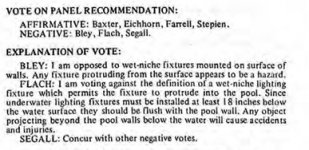NEC changes are managed by Panels. NFPA maintains the history of all the panels. Recent history, post 1974 or so, has good history of ROPs (Report on Proposals (ROP) = recommended changes and outcome from proposals). Panel 17 owns management of 680. Panel 17, 1965 has no ROP, just the code at the time. 1968 is the same, no ROP and the code INCLUDES the 18" requirement. You would likely have to find someone on the panel between 1965 and 1968 to get an answer to this question.
The first mention of the 18" in the 1971 ROP:
View attachment 471859
It gives a bit of insight on the thinking. This paragraph was on the a recommendation for definition of wet niche. Hazard and accidents and injuries noted. My opinion is the following: At the time, 120V, large format, glass lense pool lights were the norm. The area of the pool down to 18" was likely viewed as a place where your knees would hit the wall when you would pull yourself out of the pool.
Maybe I'm completely wrong, and alternatively, it might be for freeze protection...If you lower your pool water in the winter 4" below the skimmer, then the water level is ~6" lower than normal water level...leaving 12" for a freeze zone.
We may never know the answer...







